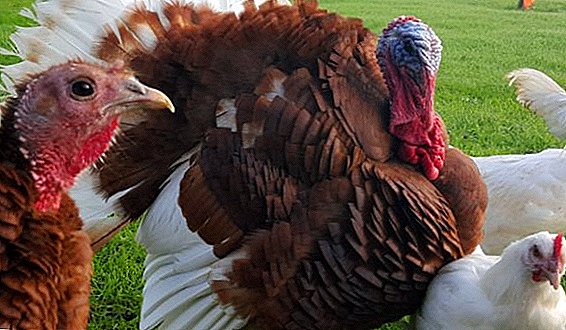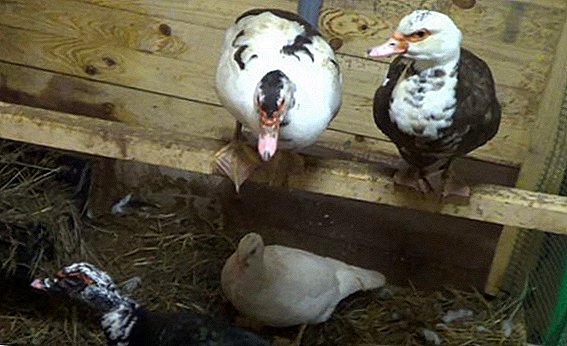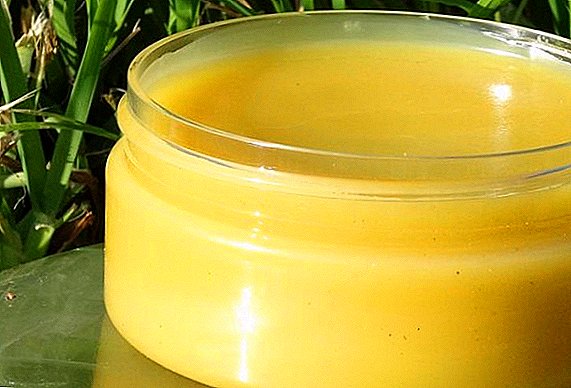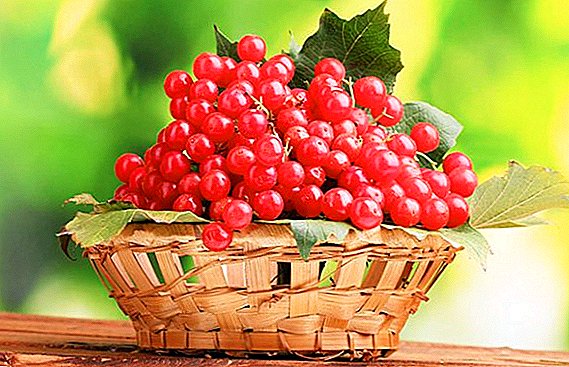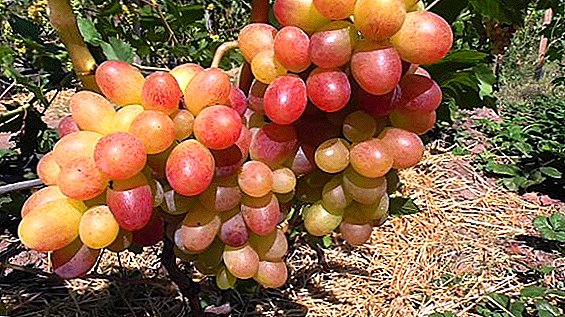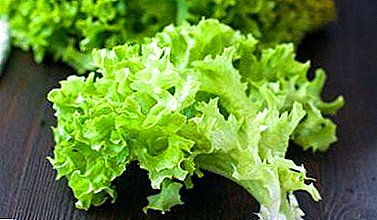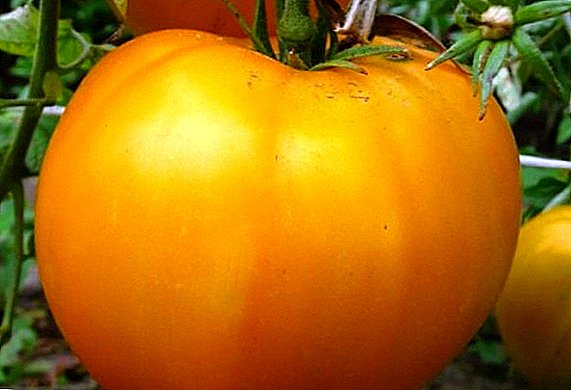 Tomatoes are vegetables that everyone loves. Their yellow varieties, besides their main purpose, also perform a decorative function. Agree, greens diluted with yellow-orange flowers look very elegant. Just such a large and incredibly tasty tomato of the variety “Orange giant”, the characteristics and description of which we will present further, will decorate your beds and will delight you with great taste.
Tomatoes are vegetables that everyone loves. Their yellow varieties, besides their main purpose, also perform a decorative function. Agree, greens diluted with yellow-orange flowers look very elegant. Just such a large and incredibly tasty tomato of the variety “Orange giant”, the characteristics and description of which we will present further, will decorate your beds and will delight you with great taste.
Description and photo
Of course, familiarity with any vegetable culture begins with a description of plants and fruits. Therefore, to begin with, let us characterize these parameters. 
Did you know? Tomatoes were grown in the VII-VIII century AD, the ancient Incas and Aztecs, and in Europe this vegetable was only in the XVI century.
Bushes
Tomato "Orange giant" is quite high - the bushes grow up to 130-170 cm. Most often, the bush is formed into two stems, but the one-stem variant is not excluded.
Fruit
Ripe tomatoes reach a weight of 350-500 g (by adjusting the ovaries, you can achieve great results - up to 700 g). The shape of the fruit is round, heart-shaped. Ripe tomatoes are fleshy, sweet, do not crack. 
Characteristic variety
Tomatoes "Orange giant" - a young variety grown in 2001 by Russian breeders. Popularity, he won pretty quickly.
This variety is mid-season; 110-120 days pass from the first shoots to the first ripe fruits. It is possible to grow up this handsome man both in the greenhouse, and in an open ground. In the protected ground, the bushes grow higher, and the fruits ripen faster.
Check out other varieties of yellow tomatoes: "Persimmon", "Honey Spas", "Golden Domes", "Orange", "Honey Drop".
Sufficiently productive variety, with a bush can collect an average of 5 kg of juicy fruits. Fruits are not suitable for long storage. But this disadvantage is compensated by the fact that the bush has been bearing fruit for a long time, which means that the whole season you will have juicy sweet tomatoes on the table.  In the southern regions, the Orange Giant grows well in the open, and in the middle lane and the northern regions it is better to grow this tomato in film shelters and greenhouses.
In the southern regions, the Orange Giant grows well in the open, and in the middle lane and the northern regions it is better to grow this tomato in film shelters and greenhouses.
Advantages and disadvantages
No matter how hard breeders try, each new culture has its advantages and disadvantages. The benefits of tomato "Orange giant" include:
- large fruits;
- resistance to lack of moisture and temperature changes;
- high immunity to various diseases;
- bright interesting color;
- good presentation.
 Among the disadvantages of gardeners note the obligatory fertilization of plants during the period of growth and a certain weakness of the branches.
Among the disadvantages of gardeners note the obligatory fertilization of plants during the period of growth and a certain weakness of the branches.Did you know? Tomatoes - leaders in the production of fruits and vegetables. More than 60 million tons of tomatoes are grown in the world annually, which is 25% (or 16 million tons) more than bananas. In third place are apples (36 million tons) and melons (22 million tons). China is leading in tomato production (16% of the world total).
Features of growing
Compliance with the basic rules of planting - the key to a good harvest. It is in their implementation that all characteristics that breeders promise when describing a variety can be achieved from a culture.
Sowing seeds for seedlings
The crop will depend on the quality and planting of the seeds. Before planting, seed should be soaked in a weak solution of potassium permanganate. Thus, the future plant can be made more resistant to various diseases.  To get healthy strong seedlings, seeds are sown at the beginning of March (40-70 days before planting in the ground) in separate containers or in one common container. The soil must contain a sufficient amount of nutrients.
To get healthy strong seedlings, seeds are sown at the beginning of March (40-70 days before planting in the ground) in separate containers or in one common container. The soil must contain a sufficient amount of nutrients.
After the seed has been planted, the containers are covered with film or glass and transferred to a room with a temperature of + 23 ... +25 ° C. When the first shoots appear, the shelter is removed and the temperature is reduced.  If the seeds were planted in a common container, the shoots need to dive. They do this when 2-3 leaflets appear on the seedlings.
If the seeds were planted in a common container, the shoots need to dive. They do this when 2-3 leaflets appear on the seedlings.
Before replanting to a permanent place, seedlings are fed 2-3 times. To do this, use a complete fertilizer, including, in addition to nitrogen, phosphorus and potassium, trace elements such as zinc, molybdenum, iron.
A week before planting the seedlings begin to harden. To do this, the seedlings are periodically taken out into the street. 
Did you know? Colonel Robert Gibbon Johnson in 1822, to prove to everyone that tomatoes are not poisonous, ate a bucket of tomatoes right in front of the courthouse in New Jersey. Since then, this vegetable has become popular.
Carrying seedlings in the greenhouse
Seasoned hardened and grown until the appearance of full leaves in the second half of May can be transplanted into protected ground. It should be remembered that the optimal scheme for planting is 50x60 or 70x40 cm. 
Planting in open ground
For the variety "Orange Giant", the seed germination time is about two months. After that (in the first half of June) the seedlings can be safely transferred to the open ground and not be afraid of frost.
Agrotechnical culture
The harvest depends on the growing conditions and agrotechnology. Therefore, in order not to be disappointed in the variety, the Orange Giant tomato should be grown in light, heavy loamy nutrient soils. This tomato responds very well to watering and feeding.
A place for planting tomatoes should be sufficiently lit and protected from strong winds. Between the beds and bushes should be observed a distance of about 50 cm. At the same time, they try to grow no more than 2-3 bushes per square meter.
At the same time, they try to grow no more than 2-3 bushes per square meter.
Important! The ideal precursors of tomatoes: onions, cabbage, legumes, cucumbers.
Bushes form most often in 1 stalk and tie up to pegs.  Further care goes according to the standard scheme:
Further care goes according to the standard scheme:
- regular watering with settled warm water;
- periodic loosening;
- hilling;
- feeding 2-3 times during the growing season with potash and phosphate fertilizers, then - less often, with complex feeding.
Important! Because of the height of the bush and the severity of the fruit, the bushes need a garter and enough space for the growth of tomatoes, otherwise the crop will be poorer.Tomatoes ripen in August and September. With the observance of the cultivation of agricultural technology with one square meter can harvest:
- in open ground - about 8 kg;
- in protected ground - 5-7 kg.
Diseases and pests
 Unfortunately, there are still no varieties that are not exposed to diseases and pests. But breeders are constantly working to resolve this issue, and each new species has a more resistant immunity.
Unfortunately, there are still no varieties that are not exposed to diseases and pests. But breeders are constantly working to resolve this issue, and each new species has a more resistant immunity.
So, the tomato "Orange giant", in the absence of preventive treatments, is unstable to such diseases as:
- tobacco mosaic;
- late blight;
- alternarioz.
Despite its vulnerability to diseases, this variety is remarkable in that it is not attacked by the Colorado potato beetle. True, this applies only to adult plants, this insect can damage seedlings. Therefore, the culture should be monitored regularly and in time to take action.  On the open field, tomatoes can be attacked by moths, aphids, whiteflies, thrips and sawflies. Fortunately, you can get rid of these pests with the help of special preparations, for example, "Lepidotsid", "Bison", "Konfidor", "Prestige".
On the open field, tomatoes can be attacked by moths, aphids, whiteflies, thrips and sawflies. Fortunately, you can get rid of these pests with the help of special preparations, for example, "Lepidotsid", "Bison", "Konfidor", "Prestige".
It was not for nothing that our gardeners recognized the Orange Giant tomato as one of the most favorite varieties. Its fruits are simply amazing in their size and rich orange color. In addition, this tomato is completely unpretentious in the care and subject to all the rules will please with a bountiful harvest.


